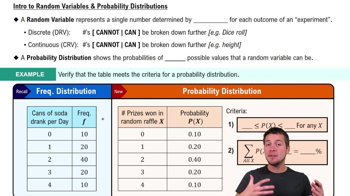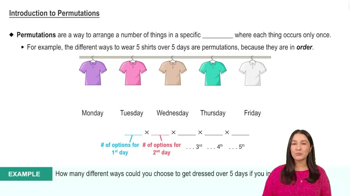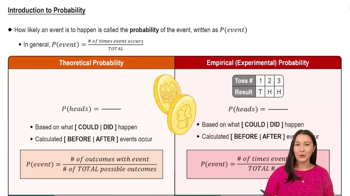Phone Numbers Current rules for telephone area codes allow the use of digits 2–9 for the first digit, and 0–9 for the second and third digits, but the last two digits cannot both be 1 (to avoid confusion with area codes such as 911). How many different area codes are possible with these rules? That same rule applies to the exchange numbers, which are the three digits immediately preceding the last four digits of a phone number. Given both of those rules, how many 10-digit phone numbers are possible? Given that these rules apply to the United States and Canada and a few islands, are there enough possible phone numbers? (Assume that the combined population is about 400,000,000.)
Table of contents
- 1. Intro to Stats and Collecting Data1h 14m
- 2. Describing Data with Tables and Graphs1h 55m
- 3. Describing Data Numerically2h 5m
- 4. Probability2h 16m
- 5. Binomial Distribution & Discrete Random Variables3h 6m
- 6. Normal Distribution and Continuous Random Variables2h 11m
- 7. Sampling Distributions & Confidence Intervals: Mean3h 23m
- Sampling Distribution of the Sample Mean and Central Limit Theorem19m
- Distribution of Sample Mean - Excel23m
- Introduction to Confidence Intervals15m
- Confidence Intervals for Population Mean1h 18m
- Determining the Minimum Sample Size Required12m
- Finding Probabilities and T Critical Values - Excel28m
- Confidence Intervals for Population Means - Excel25m
- 8. Sampling Distributions & Confidence Intervals: Proportion1h 12m
- 9. Hypothesis Testing for One Sample3h 29m
- 10. Hypothesis Testing for Two Samples4h 50m
- Two Proportions1h 13m
- Two Proportions Hypothesis Test - Excel28m
- Two Means - Unknown, Unequal Variance1h 3m
- Two Means - Unknown Variances Hypothesis Test - Excel12m
- Two Means - Unknown, Equal Variance15m
- Two Means - Unknown, Equal Variances Hypothesis Test - Excel9m
- Two Means - Known Variance12m
- Two Means - Sigma Known Hypothesis Test - Excel21m
- Two Means - Matched Pairs (Dependent Samples)42m
- Matched Pairs Hypothesis Test - Excel12m
- 11. Correlation1h 6m
- 12. Regression1h 50m
- 13. Chi-Square Tests & Goodness of Fit1h 57m
- 14. ANOVA1h 57m
4. Probability
Counting
Problem 4.4.24c
Textbook Question
ATM You want to obtain cash by using an ATM, but it’s dark and you can’t see your card when you insert it. The card must be inserted with the front side up and the printing configured so that the beginning of your name enters first.
c. How many random selections are required to be absolutely sure that the card works because it is inserted correctly?
 Verified step by step guidance
Verified step by step guidance1
Understand the problem: The card can be inserted into the ATM in four possible orientations. Only one of these orientations is correct, where the front side is up and the beginning of the name enters first.
List all possible orientations: (1) Front side up, name first (correct orientation), (2) Front side up, name last, (3) Back side up, name first, (4) Back side up, name last.
Recognize that to be absolutely sure the card works, you must test all four possible orientations, as there is no way to know in advance which one is correct.
Conclude that the number of random selections required to guarantee the correct orientation is equal to the total number of possible orientations, which is 4.
Verify the reasoning: Since there are 4 orientations and only one is correct, testing all 4 ensures that the correct orientation is eventually tested.
 Verified video answer for a similar problem:
Verified video answer for a similar problem:This video solution was recommended by our tutors as helpful for the problem above
Video duration:
2mPlay a video:
Was this helpful?
Key Concepts
Here are the essential concepts you must grasp in order to answer the question correctly.
Random Selection
Random selection refers to the process of choosing items or options in such a way that each has an equal chance of being selected. In the context of the ATM card, it implies that you might need to try different orientations of the card to ensure it is inserted correctly. Understanding this concept is crucial for determining the number of attempts needed to guarantee success.
Recommended video:
Guided course

Intro to Random Variables & Probability Distributions
Permutations
Permutations are arrangements of objects in a specific order. For the ATM card, the orientation and order of insertion (front side up and name first) create different permutations. Knowing how to calculate permutations helps in understanding the total number of possible ways the card can be inserted, which is essential for determining how many attempts are necessary.
Recommended video:

Introduction to Permutations
Probability
Probability is the measure of the likelihood that a particular event will occur, expressed as a number between 0 and 1. In this scenario, understanding the probability of successfully inserting the card correctly on the first try is important. This concept helps in assessing how many random selections might be needed to ensure that the card works, given the various possible orientations.
Recommended video:

Introduction to Probability

 7:11m
7:11mWatch next
Master Introduction to Permutations with a bite sized video explanation from Patrick
Start learningRelated Videos
Related Practice
Textbook Question
